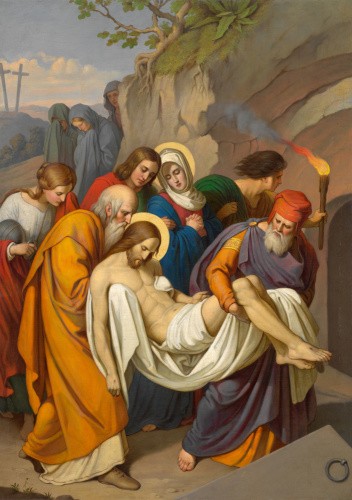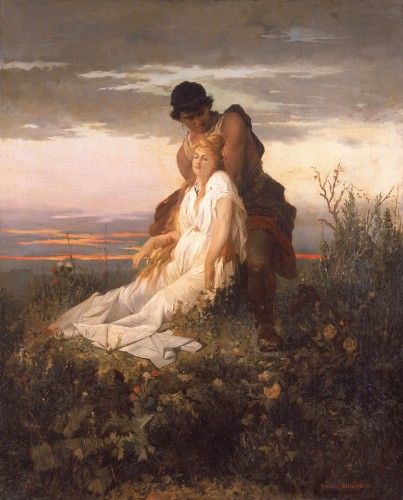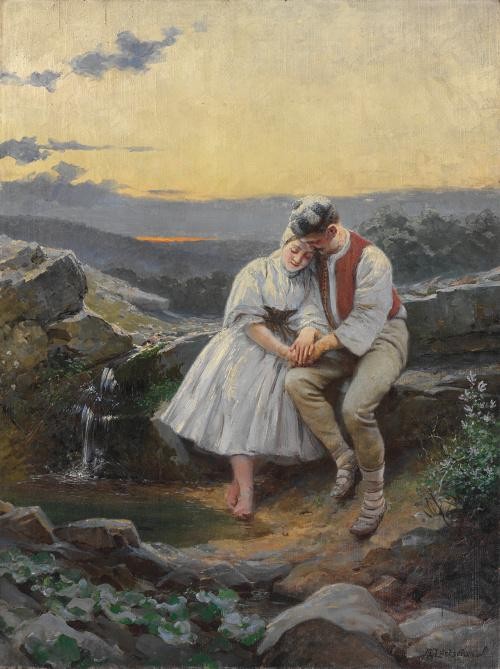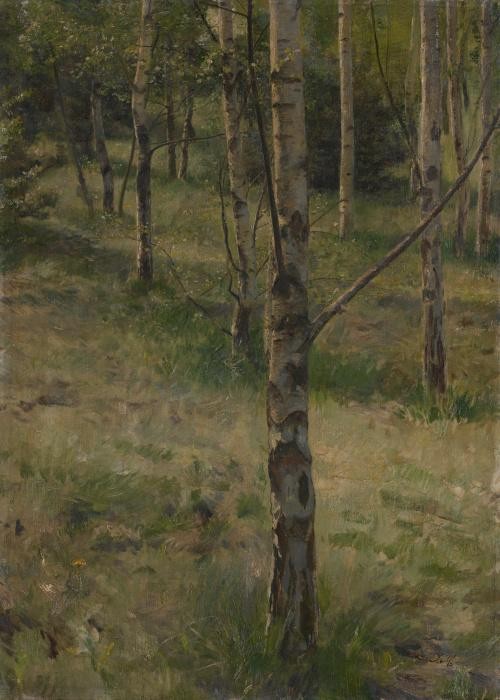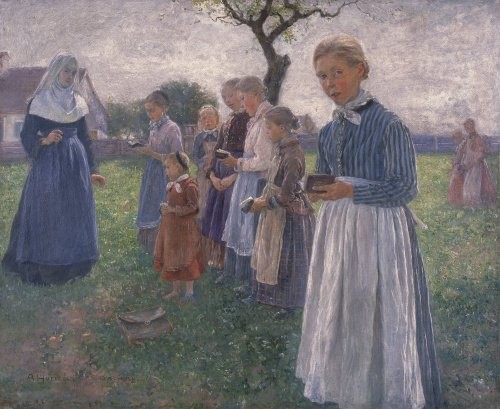Makart, Hans
Hans Makart (28 May 1840 Salzburg – 3 October 1884 Vienna)
Allegory of Sight, [1872/1879]
Oil on wood panel, 41.5 × 10.5 cm. Signed at the bottom left: Makart.
On the reverse side of the panel is the paper label (in pen): Makart H. Gesicht, another paper label with the text (typewriter): Zajištěno u Ericha Müllera /bytem Olomouc, Smetanova 29 // and the number: 105 (added in red pencil).
Private collection (on loan to the Olomouc Museum of Art from 1993).
Allegory of Hearing, [1872/1879]
Oil on wood panel, 41.5 × 10.5 cm. Signed at the bottom left: Makart.
On the reverse side of the panel is the paper label (in pen): Makart H. gehör, another paper label with the text (typewriter): Zajištěno u Ericha Müllera /bytem Olomouc, Smetanova 29 // and the number: 105 (added in red pencil).
Private collection (on loan to the Olomouc Museum of Art from 1993).
Makart was a world-famous painter, decorator and a prominent member of the Vienna art group Ringstrasse. He started to study painting at the Vienna Academy but was forced to leave. He finished his studies in Munich. He travelled to London and Paris, visited Italy and finally settled in Rome. In 1869, when he was a noted artist, he was invited to Vienna where he was given a studio at the emperor’s behest. In 1872 he established his own studio, fitted with luxurious furniture and antiquities, which soon became a popular tourist destination. Many famous figures visited his studio, for example Richard Wagner, Arnold Böcklin, Ferenc Liszt and, most importantly, Empress Elisabeth. Makart rented the studio for free to a number of artists who often depicted it in their works. When Makart returned from Egypt (1876), he was appointed a professor at the Vienna Academy. He continued travelling extensively until he finally started to run the studio of history painting at the academy in 1878. His charisma significantly changed the Viennese culture climate and his concept of “Gesamtkunstwerk” (the synthesis of artwork) fascinated his contemporaries. Makart also worked as an interior designer, stage designer and costume designer. He organized extravagant feasts for the emperor’s court, including the famous parade on the occasion of the silver wedding anniversary of the imperial couple. The parade consisted of hundreds of participants in costumes based on Makart’s designs. From 1880 to 1882, when he was the director of the Künstlerhaus, he influenced a whole generation of young artists, including Gustav Klimt. His untimely death was seen as the end of an era.
Smell, sight, hearing, touch and taste are the subjects of the classical allegory of the five senses. This theme was perfect for Makart – it allowed him to follow conventions and breach them at the same time. This also applies to the Olomouc nudes called Allegory of Sight (Face) with a mirror and Allegory of Hearing with a woman’s hand placed on her ear. These paintings are studies for Makart’s famous cycle of Five Senses (Die Fünf Sinne) which he created on commission from 1872 to 1879. Since the cycle was not bought, it ended up in the collection of Vienna’s Belvedere Palace1 and some of the studies were sold to private collectors.
Allegories allowed the decadent high society to become more and more frivolous. Beautiful women from the upper classes saw it as an honour to pose for the famous painter. Makart especially preferred the two popular daughters of the “silversmith” and former member of the Viennese city council, Josef Carl von Klinkosch (1822–1888).2 One was called Paula (1851–1901), she later married Count Jozsef Pal Szechényi-Gyula, and the other was Johanna Elisabeth Maria, called Hanna (1840–1925), who was the model for Allegory of Hearing. She was Makart’s favourite model3 till the end of his life. Much later, in 1890, she became the second wife of Prince Aloys Franz de Paula Maria von und zu Liechtenstein (1846–1920).4
Thanks to his attractive and socially established models, Makart was able to increase the visual effects of his paintings. However, his sensual and sophisticated paintings with a hidden demonic nature showed only some features of allegory. The main purpose of the paintings was an impressive depiction of provocative nudes with a special subtext. This is nothing new in art and Makart only followed his famous predecessors. The cycle of Five Senses, including Allegory of hearing depicted by a female nude, was previously created by Jan I. Brueghel together with his close friend Peter Paul Rubens.5
While Allegory of Taste is an allusion to Eve in Eden, picking up the forbidden fruit from the Tree of Knowledge (Gen, 3,6), Allegory of Sight is not so easily explainable. Similar to Eve, who succumbed to Satan’s temptation, Makart’s long-haired personification of sight tries to seduce the viewer with the sinuous curve of her body. She is captivated by her own beauty and wants to experience pleasure even if it means expulsion from Paradise.
The naivety and sugary nature of the painting is balanced by the indisputable quality of the work which fascinated Viennese society, which was enchanted by art works in the style of historicism. Makart created fairy-tale like scenes full of exotic grasses, palm leaves, bird feathers and artificial flowers which he composed into bouquets6 that became extremely popular at the time.
The final version of the cycle of Five Senses, finished in 1879, was presented at one of the grand parallel exhibitions in Belvedere Palace in Vienna (Makart: Painter of the Senses) and in the Künstlerhaus.7 These exhibitions presented the extraordinary range of the artist who influenced Viennese art circles in the time of its prime era, right before its unusual downfall during the beginning of the 20th century.8
Marie Mžyková
1. Husslein-Arco – Klee 2011, fig. 9; there is also an extensive bibliography. Info about Makart: Wurzbach 1874, p. 397n. – Pirchan 1942. – Frodl 1974. – Lehmenn 2011. – Gleis 2011.
2. Especially in 1855 he provided luxurious goods of silver, designed by renowned foreign artists, for the emperor’s and king’s court. Klinkosch’s company also produced golden and silver medals for many exhibitions all over Europe. In 1869 Klinkosch established his own company which attended the World’s Fair in Vienna in 1873 and in Paris in 1878. Klinkosch was knighted in 1879. After his death in 1889, his extensive collection of artworks was sold in auction.
3. She is depicted in a Dutch costume, similar to Rubens’s Helena Fourment.
4. He was the son of Franz de Paula von Liechtenstein (1802–1887) and the younger brother of Alfred von Liechtenstein which means he was the nephew of ruling Prince Aloys II von Liechtenstein. His first wife was author Marie Henrietta, born Fox, whom his family did not approve of.
5. The oil on wood panel painting from 1617–1618 (65 × 110 cm), created in Antwerp, is now in Madrid›s Museum del Prado.
6. Decorations called Makart’s bouquets, accompanied by ostrich or peacock feathers, butterflies or birds were created at that time. The theme also appeared on fans and other items.
7. Husslein-Arco – Klee 2011.
8. It was not until the 1970s that Makart’s works were no longer seen as kitsch and were again appreciated thanks to the rehabilitation of historicism in the German lands as well as thanks to the exhibition of history and naturalism paintings in the Musée d’Orsay in Paris in 1986.




